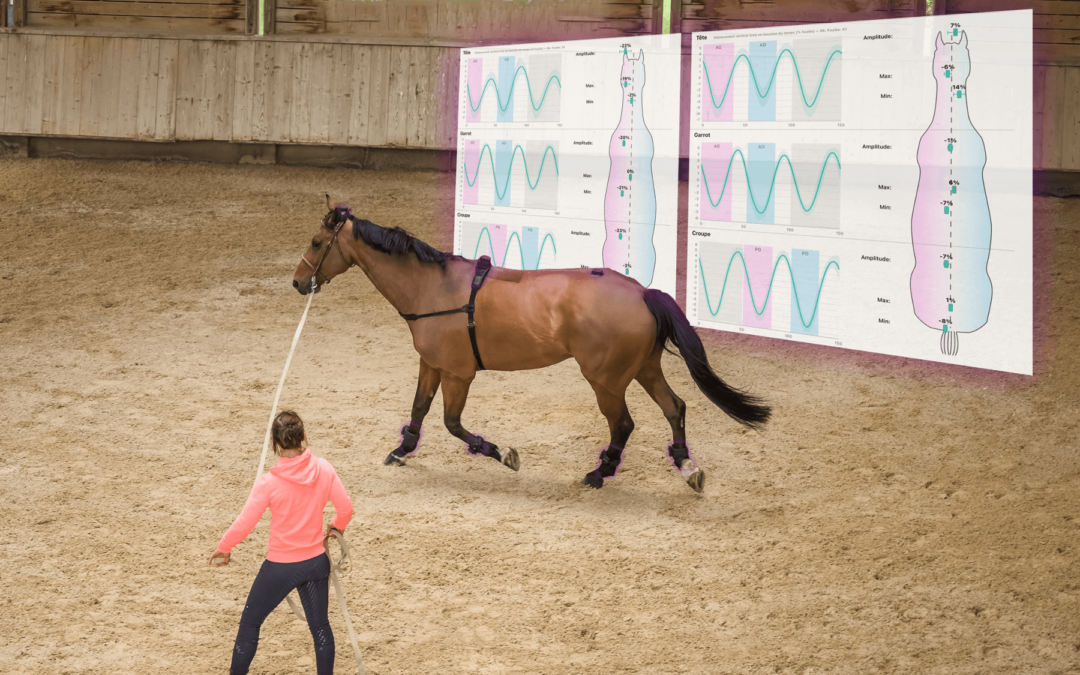The analysis of horse locomotor asymmetry is part of a veterinarian’s daily routine. Usually, the veterinarian analyzes and evaluates changes in the vertical movements of the head and trunk during a stride in order to establish a diagnosis. In this article, we will describe how EQUISYM assists veterinarians in the evaluation of locomotor asymmetries and lameness diagnosis.
EQUISYM : VETERINARY TOOL HELPING THE DIAGNOSIS OF LOCOMOTOR ASYMMETRY
EQUISYM is a veterinary tool that assists veterinarians in assessing locomotor asymmetry in their daily practice. It can measure and quantify vertical displacements stride by stride thanks to its 7 non-intrusive inertial sensors.
It is a fully automated system based on the development of algorithms that process data from sensors. Measurements taken during a clinical examination are segmented automatically. The information proposed by the system is therefore focused only on the interesting conditions (straight line trot, circle, …), correlated to the limb stance phase, and presented in a synthetic way with an average stride (average of all strides of the same condition) and/or synchronized with the video recorded simultaneously by the tablet camera.
The result is represented by displacement curves for each of the three areas of interest (head, withers and pelvis). In order to evaluate the locomotor asymmetry, an average curve (on the recorded strides), as well as the standard deviation, enables the analysis of different key parameters.

Illustration of the vertical displacements : Head, Withers, Pelvis measured by the EQUISYM system on a healthy horse.
HOW DOES EQUISYM ASSIST THE LAMENESS DIAGNOSIS?
When a horse is lame, the amplitude of vertical movement of the head and trunk decreases during the stance phase of the diseased limb’s diagonal. For the diagonal of the healthy limb the vertical displacement amplitude increases. Because of an increase in vertical displacement amplitude, the symmetrical and sinusoidal pattern of vertical displacement described in the healthy horse at trot becomes asymmetrical in the lame horse.
In order to quantify and objectify these observations, EQUISYM proposes the analysis of 3 key parameters. We used the withers with the left and right forelimbs as an example for each parameter :
The MINIMUM corresponds to the minimum altitude reached during the drops on the member. It reflects the weight of the limb, which may be more or less important.

Minimum altitude reached during vertical displacement of the withers. On this asymmetrical horse, the drop of the right forelimb (RF) is lower than that of the left forelimb (LF) with a minimum difference in altitude of 1.2 cm.
The MAXIMUM corresponds to the maximum altitude reached after the vertical propulsion on the limb.

Maximum altitude reached during vertical displacement of the withers. It can be seen on this asymmetrical horse that the vertical propulsion of the right forelimb (RF) is weaker than that of the left forelimb (LF), with a maximum difference in altitude of 1.0 cm.
The vertical AMPLITUDE is measured. It translates the global asymmetry by taking into account the variations of min and max. Still for the withers, this gives the following curve.

Vertical amplitude during propulsion at the withers. In this asymmetrical horse, the vertical amplitude between min and max of the right forelimb (RF) is lower than that of the left forelimb (LF).
For each of these parameters, synthetic indicators are calculated to quickly determine the origin and importance of the left-right asymmetry.

In the center, the vertical displacement curves of the head, withers and pelvis in % of stride of a horse considered healthy. The green curve represents the average of 21 measured strides. On the right, the indicators show the % of difference between the left and right half stride. An indicator moving to the right will indicate an asymmetry in the measured parameter (amplitude, min, max) of the right limb (and reciprocally for the left).
For forelimbs lameness, the modification of these parameters is visible on the sensor of the head and withers (and of the pelvis for the hindlimbs).

The vertical amplitude asymmetry of the right forelimb is highlighted by the figures proposed by the system on the curves (1.6cm difference for the withers, for example) but also by the indices presented on the right (19% default on the right). We can see that the data proposed by the head sensor follows the same trends. On the other hand, the movement of the pelvis shows a symmetrical locomotion of the hindlimbs.
CONCLUSION
Using a locomotion quantification system brings objectivity to a very subjective field of expertise. As previously presented, EQUISYM allows quantifying locomotion with precise and objective data, useful for orienting the diagnosis, grading lameness, or analyzing the effect of diagnostic anesthesia. The 7 sensors positioned on the horse provide a global view of locomotion and allow a complete examination of the horse in just a few trips.
EQUISYM provides many other advantages: intelligent and simultaneous reading of movement curves and their linked videos, classification and data archiving, etc. New perspectives are therefore possible. For example, long-term monitoring of horses by comparing different examinations carried out over time.
Keywords: locomotor asymmetries, equine lameness, locomotion quantification, veterinarians, Data-Science


